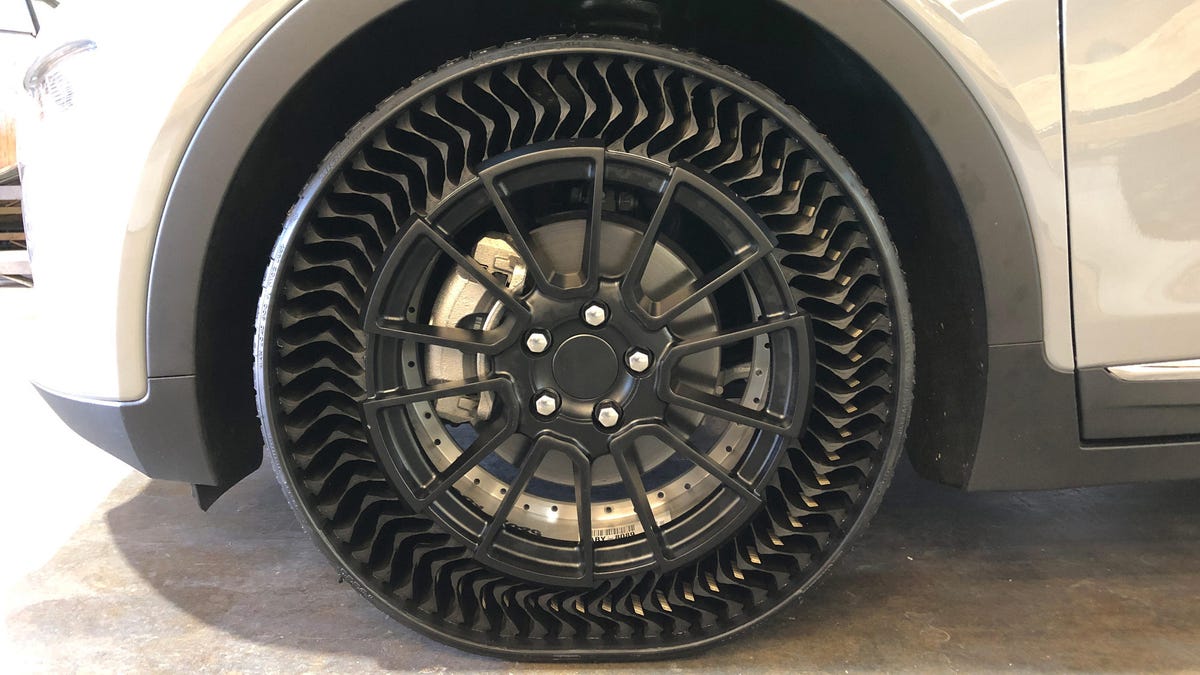Why GM and Michelin's airless Uptis is the future of car and truck tires
The airless tires are expected to launch on a General Motors vehicle by 2024.

This could be the future of tires.
Remember the Michelin Tweel, that futuristic-looking tire supported by rubber spokes instead of pressurized air? If not, you may get acquainted with this space-age design sooner rather than later.
The French rubber-goods manufacturer has developed a strikingly similar tire that's expected to land on public roads within the next few years. The prototype name for this in-development product is Uptis, shorthand for Unique Puncture-Proof Tire System. Undoubtedly, the firm's marketing department will come up with something more appealing than that before the tires go on sale.
The Uptis, or whatever it ends up being called, is scheduled to launch on a General Motors vehicle as early as 2024, "[But] probably not sooner than that," at least according to Steve Cron, senior principal product engineer at Michelin, who Roadshow spoke to at a media event on Wednesday. The two giant companies have been working together on this project, with the Chevrolet Bolt all-electric hatchback serving as the development platform.
Compared to a conventional pneumatic tire, the Uptis offers numerous benefits. The most obvious of which is never having to deal with a flat again, so feel free to run over as much broken glass, miscellaneous debris or even drywalls screws as you want. These tires require no maintenance, no periodic air-pressure checks. Any vehicle fitted with Uptis tires can do away with a jack, spare and any tire pressure-monitoring hardware, which saves weight and cost, two things automakers absolutely hate.
An advantage of the Uptis is that these tires can be re-treaded.
But those aren't the only advantages of the Uptis. Cron said the tires can potentially be re-treaded. As they wear out, rather than replacing them with a new set, a fresh layer of rubber can be applied to the outside, as is done with large tires used on tractor trailers and other heavy equipment. This means Uptis could potentially last the life of a vehicle. They also have "very high lateral stiffness," which Cron noted can improve vehicle handling.
The Uptis builds on what Michelin learned creating the Tweel, which went on sale about five years ago and is available for use on non-roadgoing-vehicles like skid-loaders, lawn mowers and ATVs. All told, Cron said the Uptis is the result of about 21 years of development work.
Currently, this exciting new tire design is undergoing small-scale testing, though it sounds like there are no deal-killing reasons why it couldn't be used on roadgoing motorcars. Cron has already extensively tested the Tweel on public streets. "I had it on my car," he said. "I drove every day for four years." And during that period Cron had zero issues. "Of course, I never had a flat tire," he said. But a mere two weeks after reverting to conventional tires he did.
One reason the Tweel is not intended for use on cars and trucks is that it's specifically designed for more industrial applications. In everyday use, Cron said, "[The] ride quality, it was too harsh." This is because Tweels have polyurethane-reinforced spokes for added stiffness. In comparison, the Uptis is all rubber, strengthened by fiberglass and resin. Their spokes also work both in compression and tension, making them more flexible.
GM is currently testing the airless tires on the Chevy Bolt EV.
Another downside to running the Tweel on-road is noise. Cron said on flat surfaces they were comparable to normal tires but impacts from bumps and potholes broadcast much more racket because of the tires' overall starchiness.
Harshness like this should not be an issue with the Uptis and its more pliable design. "Ride quality ... is better than a run-flat [but] not quite as good as a Michelin pneumatic tire," said Cron. They may also be quieter than their air-filled counterparts as they produce no cavity sounds -- those thwap noises a tire makes when hit by road imperfections.
With its open design you'd think the Uptis would need sidewalls to keep snow, ice and mud out of the spokes, but Cron said, "Really, it is not a problem." According to him, debris quickly gets forced out after you drive just a few meters. Capping these tires is more a question of looks and aerodynamics he explained.
As for cost, nothing is official yet as the Uptis is still years away from hitting the market. But they should be comparably priced to a run-flat tire, which is the benchmark product Michelin has been targeting during development. Look for the Uptis to launch on a GM vehicle around the year 2024.

